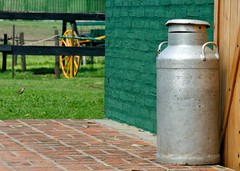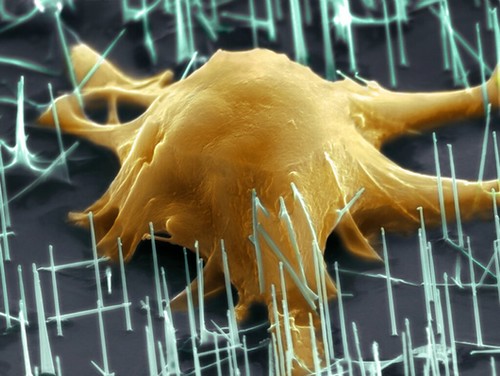
Monday, May 21, 2012
Power from straw is hotting up in the East
Construction of the UK's second straw-fired power station has just got under way in Lincolnshire, and with more projects in the pipeline, demand for straw is hotting up across the eastern counties.
Once complete, the 38MW Sleaford Renewable Energy plant will use about 240,000t of biomass a year, mainly large-bale (Hesston or Quadrant-type) wheat straw from within a 50-mile radius of the site. It will also be able to take straw from other crops, such as oilseed rape, and up to 40,000t of chipped wood, from willow coppice and clean, untreated wood.
The facility is based on a similar model to the Ely straw-fired power station in Cambridgeshire, which uses more than 200,000t of straw a year sourced from local farms on long-term contracts.
Planning permission for the Sleaford plant was granted in November 2008 and commercial operation should begin in January 2014, says David McDonald, operations director for development company Eco2.
"The majority of our fuel supply had to be in place prior to securing finances, so we've contracted 150,000t already, but we are looking to procure more fuel and will be taking straw from next harvest [2013]. Security of fuel supply is obviously very important to us, so we're also going to have 60,000-70,000t of buffer straw supply to mitigate volume and price fluctuations."
In addition to the Sleaford plant, he says the company was looking to sign up straw suppliers for another 38MW plant further north in the county at Brigg, which has got planning permission and is in the final stages of arranging finance. Planning permission for a third straw-fired plant at Mendlesham in Suffolk is also being applied for.
Together, the three new plants, combined with the existing Ely site, could take about 800,000t of straw in the future from local growers.
Contract details
As with other power station contracts, security of fuel supply is the main consideration for the operators at the Sleaford plant, so long-term contracts are used.
Straw suppliers are asked to sign up to a given tonnage for 12 years, with no break clause, although in the event of exceptional market or legislative changes not reflected in the initial contract, there may be scope for renegotiation, Mr McDonald says.
There is a minimum supply of 250-300t, but no maximum. Farmers are responsible for storing the bales until needed and payment will be made 30 days after straw is collected.
Mr McDonald says the exact contract price remains confidential as it depends on individual circumstances, but it is index-linked and at a level that makes it "worthwhile" for farmers and the power station. The final payment to farmers will be based on 15% moisture, and reduced on a sliding scale for wetter loads up to a maximum of 25% moisture.
"The price won't reflect the volatility of the straw market, so some years suppliers will gain, other years they'll lose. The main thing is that the contracts provide stability. I'd never recommend a farmer commits their entire straw tonnage to it, but at least its another option to consider."
Fieldsmen will regularly inspect straw stacks to check degradation and Mr McDonald says there may be scope to arrange collections around individual farm circumstances. However, in many cases, the length of storage on farm will depend on when the power station needs the straw and its own logistical planning.
Word of caution
Brown & Co's Rob Meadley says such power station contracts provide a good alternative income stream and price stability, but he advises any farmers considering them to do so carefully.
The term of such supply contracts (typically three to 10 years) is longer than many other contracts growers may be used to, so a long-term impact assessment is advisable. This should consider things such as possible soil compaction from balers and loaders, loss of soil organic matter, and the cost of extra fertiliser required to meet nutrient loss (particularly phosphate) from continuous straw removal.
In addition, there may also be an impact on timeliness of drilling following crops, particularly where baling and clearing fields in a catchy harvest could delay the early establishment of oilseed rape, he says. Power stations normally want an even supply of material through the year and farmers are generally responsible for loading lorries when they come to collect straw. "These extra 'hassle factors' can be difficult to put into monetary terms," Mr Meadley says.
Another key consideration is the amount of straw to commit to the contract. Most are based on a fixed tonnage that must be supplied each year, so play it safe by assessing what is the maximum volume you could provide in a bad wet or drought-hit year, he advises. "Contracts usually have some leeway on volume of plus or minus 5-10% depending on the season, and if it's classed as an exceptionally wet year or severe drought, force majeure may apply.
"Up to 25% moisture will normally be accepted, although price will be reduced accordingly."
Minimise losses
Stacking bales correctly helps prevent wastage, although Mr Meadley reminds farmers to observe health and safety guidelines - see www.hse.gov.uk/pubns/indg125.pdf
The top layer of bales can often end up being wasted, but the sides are normally OK, and if bales are on hardstanding, the bottom layer should be useable, too, he says. "But be clear on the exact bale dimensions required by the power station and remember that the bottom bales can sometimes get squashed and be outside the size specification required. It's good to make sure you fully understand the process that goes on in the power station and how this affects what they want."
Insurance is also important, as bales normally remain under the ownership of the farm until they are on the lorry for delivery to the power station. "If anything did happen to the straw, such as arson, it would be down to the farmer to replace the tonnage from the open market to fulfil the contract. Hopefully, the insurance value would cover the cost of buying in the straw required, so it's worth speaking to your insurer about any plans."
paul.spackman@rbi.co.uk
About 800,000t of straw would be required by specialist power plants in the eastern counties over the next few years.
Sleaford straw supply contract
* Fixed tonnage for 12-year term
* Price linked to Retail Prices Index and element of fuel escalator
* Price based on 15% moisture
* Minimum contract tonnage 250-300t
* Bale size requirements :- length: 2,250mm (up to 2,650mm)
width: 1,150mm
(up to 1,250mm)
height: 1,220mm
(up to 1,320mm)
* Find out more at www.sleafordrep.co.uk
Source Citation
"Power from straw is hotting up in the East." Farmers Weekly 18 May 2012. Agriculture Collection. Web. 21 May 2012.
Document URL
http://go.galegroup.com/ps/i.do?id=GALE%7CA290033128&v=2.1&u=22054_acld&it=r&p=PPAG&sw=w
Gale Document Number: GALE|A290033128
Monday, May 14, 2012
If milk processors are worried about the security of supply thenthey've got a funny way of showing it
This week's massive price cuts, initiated by Dairy Crest and followed by Robert Wiseman Dairies and others, are a hammer blow to an industry that until recently appeared to be gaining an air of confidence, with fewer farmers leaving the sector and more planning to expand.
At 2p/litre, the scale of the cuts was bad enough, but Dairy Crest's decision to give its non-aligned suppliers just four days notice stoked up more anger and highlighted the weakness of farmers in a somewhat dysfunctional supply chain.
Both Dairy Crest and Wiseman blamed the cuts on tough retail conditions and falling commodity prices, but why is it that such price corrections always seem to come much quicker when markets are falling than when they're on the way up?
The essence of milk processors' arguments may be true, but they hold little weight with farmers who face production costs outstripping milk price by about 3p on every litre. It is a cruel irony that farmers aligned with the supermarkets on cost-tracking-type contracts are now the ones receiving the highest prices.
Only half of dairy products consumed are in liquid form, but milk is a key product for retailers. When times get tough, it is one of the first to be discounted to draw shoppers into stores. The retail price for a four-pint polybottle, for example, has actually fallen by about 35p over the past four years, when we've seen food inflation soar for most other products. Cheese has also been subject to some ridiculously cheap deals. If a little more was available from the retail end, surely it would ease the pressure for all further along the chain?
Processors, too, should look at their operations and decide whether volatile commodity markets are really the best home for UK milk. It's no use using farmers to protect wafer-thin margins, because eventually those farmers will snap.
Notice periods of up to 12 months for many contracts make it difficult for farmers to switch buyers quickly though. This needs to change if producers are going to gain more faith in their supply chain and the confidence to reinvest.
If we're looking for a silver lining to these dark clouds, ironically, the drastic cuts announced this week may actually improve the scope for changes to contracts. Unusually, DEFRA has commented on milk prices, so the issue is making it onto the wider political radar.
Processors and retailers need to learn from the reaction to these price cuts and remember that farmers do have other options for using their land, whereas a dairy facility is of no use without raw milk. Let's hope that other processors can show strength by resisting making similar cuts and in turn protect those promising shoots of recovery.
Paul Spackman Deputy business editor
Q News p6
Q Business p22
Source Citation
"If milk processors are worried about the security of supply then they've got a funny way of showing it." Farmers Weekly 4 May 2012. Environmental Studies and Policy. Web. 14 May 2012.
Document URL
http://go.galegroup.com/ps/i.do?id=GALE%7CA288574050&v=2.1&u=22054_acld&it=r&p=PPES&sw=w
Gale Document Number: GALE|A288574050
Thursday, April 5, 2012
Staying dry at the start of the rain
Alex and Lulu a dog and a cat are best friends who share every part of their day. As the day progresses Alex and Lulu realize they do not agree on everything. For instance when it starts to rain Lulu wants to rush home but Alex "doesnt want to stay dry" and wants to take his time; at another point Alex thinks about playing soccer but then remembers Lulu doesnt like soccer because it "squashes" her flowers. Their day continues like this: Lulu is calm and observant while Alex is active and adventurous.
Siminovichs illustrations fill the pages with a wide variety of colors and textures. Bright reds and blues are mixed in with polka dots textured walls and rain puddles and chalk-like drawings of buildings and furniture. The text is integrated into the illustrations allowing the reader to delve further into the art.


Thursday, March 25, 2010
Mouse embryonic stem cell


It was in Toronto, in the summer of 2006, that stem-cell research was turned upside down. I remember it clearly, but I didn't feel the earthquake at the time: a youngish, earnest Japanese researcher named Shinya Yamanaka gave a talk at the annual meeting of the International Society for Stem Cell Research, reporting that he could make mouse skin cells look and act like embryonic stem cells just by adding a few genes. The following year, both Yamanaka and Rudolf Jaenisch, a well-respected stem-cell researcher from MIT, reported that these induced pluripotent stem cells (known as iPS cells) passed the litmus test for pluripotency, or the ability to differentiate into all types of cells: when mouse iPS cells were injected into mouse embryos, the cells were incorporated into the developing mice.
Since then, research based on iPS cells has exploded (see "Medicine's New Toolbox," p. 40). Like embryonic stem cells, iPS cells can give rise to different types of tissue, but they offer a way to avoid both the ethical and practical hurdles of dealing with human embryos. Scientists have made human iPS cells from skin and hair follicles, as well as from tissue harvested from people with various ailments. Methods for making these cells are evolving at breakneck speed; the most recent development, as of this writing, is the transformation of human skin cells into iPS cells using proteins rather than the currently most common approach of genetic engineering.
Given the rapid successes of iPS-cell research, some have argued that we should abandon human embryonic stem cells. This is a very bad idea. We should continue, and even intensify, the study of these stem-cell lines.
We know much more about embryonic stem cells than we do about iPS cells. The relatively few embryonic-stem-cell lines in existence have been well characterized by many scientists. However, the rapidly growing number of iPS-cell lines, and the new methods of deriving them, have overtaken our capacity for characterizing them. There are too many iPS-cell lines to count, much less analyze.
Some iPS-cell lines are likely to bear close resemblance to embryonic stem cells. But others will be dearly different--perhaps more or less prone to develop into tumors, or with different degrees of potential for differentiation. IPS cells may be better than embryonic stem cells for some uses, but worse for others. We have to find out, not just guess, because people's health is at stake.
I embrace the new technologies, and I want to use them all, but we still need to pick the right cells for the right jobs. IPS cells and embryonic stem cells must be compared, directly, by a lot of scientists in a lot of ways before we can think seriously about what cells to use for medical applications.
JEANNE LORING IS FOUNDING DIRECTOR OF THE CENTER FOR REGENERATIVE MEDICINE AT THE SCRIPPS RESEARCH INSTITUTE IN LA JOLLA, CA.
Source Citation
Loring, Jeanne. "Cell fate: Jeanne Loring explains why we can't abandon embryonic stem cells." Technology Review [Cambridge, Mass.] 112.4 (2009): 12+. InfoTrac Environmental Issues and Policy eCollection. Web. 25 Mar. 2010.
Document URL
http://find.galegroup.com/gtx/infomark.do?&contentSet=IAC-Documents&type=retrieve&tabID=T003&prodId=SPJ.SP04&docId=A204034399&source=gale&srcprod=SP04&userGroupName=broward29&version=1.0
Gale Document Number:A204034399
Disclaimer:This information is not a tool for self-diagnosis or a substitute for professional care.



